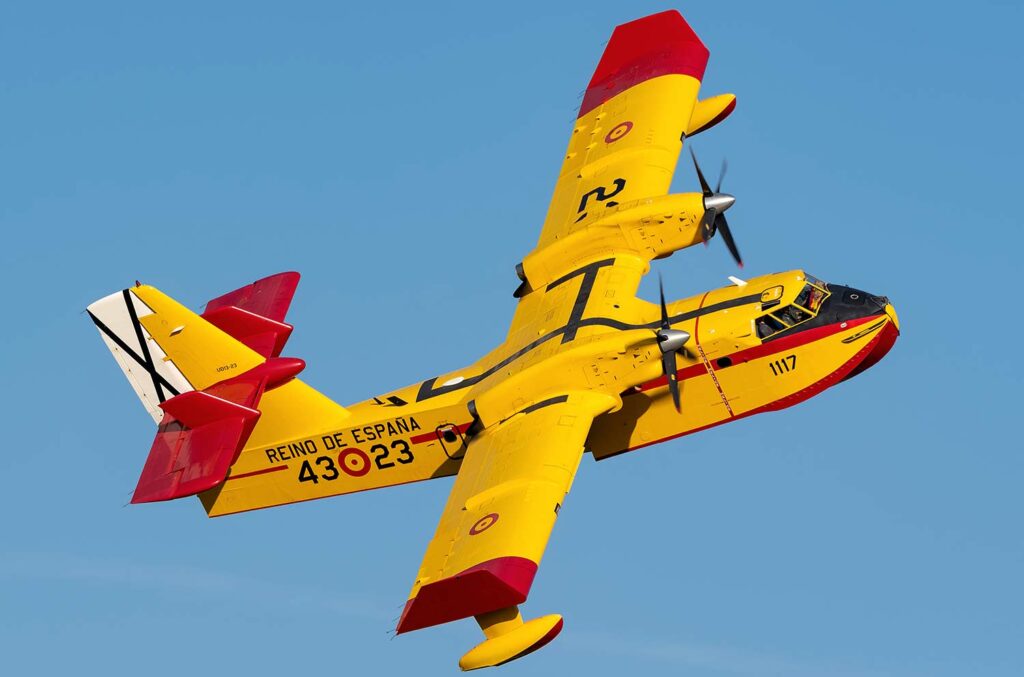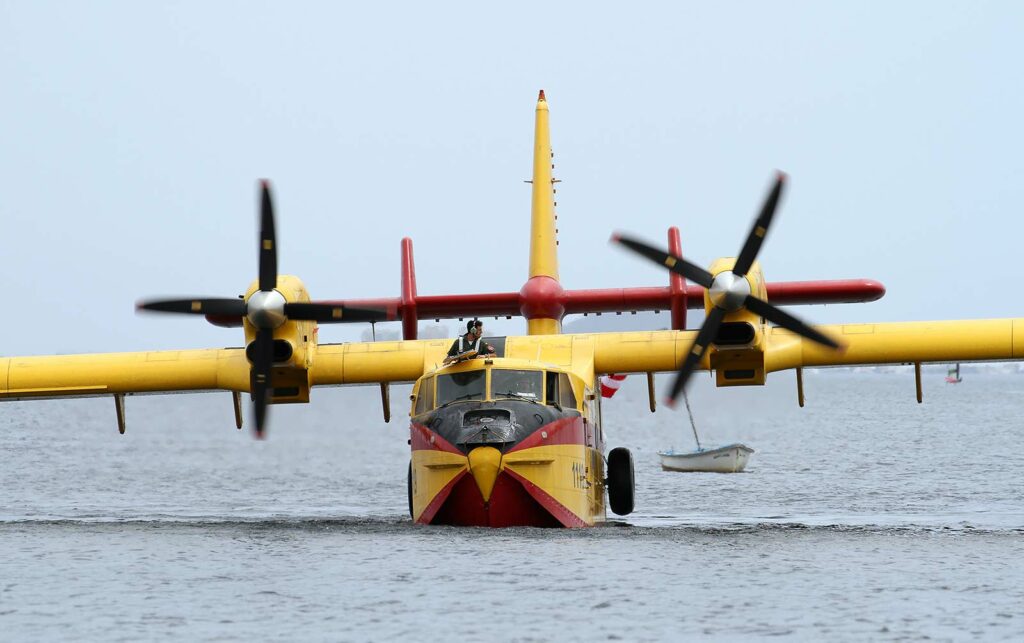The Canadair CL-215 is a twin-engine, amphibious aircraft designed primarily for firefighting, excelling in water scooping and dropping.
In brief
The Canadair CL-215, the first model in a series of firefighting flying boat aircraft, is a distinctive amphibious aircraft optimized for water scooping and dropping on wildfires. Introduced in the 1960s, it has a unique capability to scoop water from lakes and rivers, combining it with additives if necessary, and accurately dropping it on fires. Equipped with two powerful Pratt & Whitney R-2800 piston engines, it’s designed for stability and low-speed handling, crucial for its firefighting role. Its versatility also extends to search and rescue, cargo transport, and maritime patrol, making it a multifunctional asset for various agencies worldwide.

History of the Development of the Canadair CL-215
The Canadair CL-215 was developed in response to the growing need for effective aerial firefighting methods. During the 1960s, wildfires were becoming increasingly prevalent and destructive, prompting the search for specialized aircraft that could combat these disasters efficiently. Canadair, recognizing the market demand, initiated the CL-215 project, aiming to create an aircraft capable of rapid, repeated water scooping and dropping, operating close to fire zones, and refilling from nearby water sources.
The program was launched with the backing of the Canadian government and various provincial governments, which saw the potential for such an aircraft in their firefighting arsenals. The CL-215 made its maiden flight on October 23, 1967, showcasing its unique capabilities that were specifically tailored for aerial firefighting. While it didn’t receive a NATO nickname, its distinctive appearance and operational role earned it the moniker “Waterbomber” or “Scooper” among operators and aviation enthusiasts.
Design of the Canadair CL-215
The Canadair CL-215 was innovatively designed with amphibious capabilities, allowing it to take off and land on both water and land. Its hull was boat-shaped, optimal for water landings, and it was equipped with retractable landing gear for runway operations. The aircraft featured a high-wing configuration to keep the engines and propellers clear of the water spray during scooping operations.
The CL-215’s wingspan and large flaps allowed for low-speed flight and enhanced controllability in the demanding low-altitude firefighting role. It was equipped with Pratt & Whitney R-2800 radial engines, known for their reliability and power. The aircraft could carry up to 1,400 gallons of water, scooped in just 12 seconds from water sources as shallow as two meters, making it highly effective in combating wildfires.
One of the design drawbacks was its relatively limited speed and range, a trade-off for its optimized low-speed handling and payload capacity. The piston engines, while powerful, required more maintenance than modern turboprop engines and were less fuel-efficient.
Performance of the Canadair CL-215
The CL-215’s operational performance was tailored for the unique demands of aerial firefighting. The aircraft’s Pratt & Whitney R-2800 engines, each producing 2,100 horsepower, enabled a maximum speed of approximately 200 mph and a patrol speed optimal for firefighting missions. It had a service ceiling of around 20,000 feet but typically operated at low altitudes during firefighting operations.
Its range extended to about 1,500 miles, but operational missions were usually conducted much closer to base, given the need for rapid response to fire outbreaks. The CL-215’s ability to scoop large volumes of water rapidly from nearby lakes or rivers and deliver it precisely to fire zones was unmatched at the time of its introduction, setting a new standard for aerial firefighting.
Variants of the Canadair CL-215
The Canadair CL-215 evolved into several variants, enhancing its capabilities and extending its operational roles:
- CL-215T: A turboprop version upgraded with Pratt & Whitney Canada PW123AF engines, improving its speed, range, and reliability.
- CL-415: An advanced variant with significant upgrades, including more powerful engines, increased efficiency, and enhanced avionics, becoming the pinnacle of Canadair’s firefighting aircraft.
Each variant built on the success of the original CL-215, incorporating advancements in aerospace technology to meet the evolving demands of aerial firefighting and multirole missions.

Military Use and Combat of the Canadair CL-215
While primarily a civilian firefighting aircraft, the CL-215 has also been employed by various military forces for utility and maritime patrol roles, search and rescue missions, and environmental protection duties. Its military significance lies in its versatility and ability to operate in diverse environments, from Arctic regions to tropical climates.
The aircraft’s deployment in combat scenarios is limited, given its design as a firefighting and utility aircraft. However, its role in military operations has often been crucial, particularly in humanitarian aid, disaster relief, and search and rescue missions. The CL-215’s capacity to carry large payloads and operate from unprepared runways and water bodies makes it invaluable for rapid response to crises, delivering supplies, and evacuating casualties in areas inaccessible to most other aircraft.
Several air forces and naval services have utilized the CL-215 for coastal patrol, maritime surveillance, and anti-submarine warfare training, exploiting its low-altitude flight capabilities and endurance. In these roles, the aircraft often carries specialized equipment, including search radars, sonobuoys, and occasionally, light armament for patrol duties, showcasing its adaptability beyond its primary firefighting mission.
The CL-215 has been operated by countries such as Spain, Greece, and Canada, where its ability to perform in a dual role as a firefighting and multi-mission aircraft is highly valued. These nations have deployed the CL-215 not only for combating wildfires but also for maintaining a watchful eye over their maritime domains, providing a versatile tool in their aerial fleets.
The Canadair CL-215 represents a significant achievement in the field of aviation, specifically designed to address the exigent requirements of aerial firefighting and capable of performing versatile roles in various civilian and military operations. Its innovative design, optimized for water scooping and dropping, set a benchmark in the effectiveness of combating wildfires from the air, saving countless forests and properties while also preserving lives.
Back to the Special Aircraft section